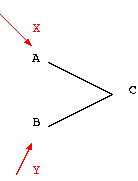
Jerry Bolton, Jr.
This paper provides supplemental information useful to readers of James Clerk Maxwell's ``A Dynamical Theory of the Electromagnetic Field.'' It contains diagrams and mathematical notes which show the steps for deriving JCM's solutions, which were omitted from his short paper. It also contains a number of alleged errata, prima rily textual, in the original JCM document. This paper is organized sequentially by JCM's original article number, and the author's notes are dated for each article.

The velocity of C as a function of the velocities of A and B:
The relation of the forces to the simultaneous displacement by the ``general equation of dynamics'':
The simultaneous displacement of C, A and B:
Solving for X and Y, we have:


However, Maxwell has later need for equations without dependency on
the simultaneous displacement. Therefore, we instead substitute for
![]() z:
z:
Distributing we have:
Maxwell concludes therefore1 that:
We substitute for
![]() :
:
Maxwell factors, distributes C and applies the sum rule of differentiation: (20010924)
The momentum of C referred to A (as Maxwell calls it) is:
The momentum of B referred to A:
In a system of many such bodies:
The momentum of the system Ais therefore (Lu + Mv)and the momentum of Bis (Mu + Nv), therefore:
The force
![]() =
= ![]() Mufollows logically because u and v
are independent. That is to say, the force
Mufollows logically because u and v
are independent. That is to say, the force ![]() must change by this
amount to stabilize Bwhen the velocity of Ais changed by
must change by this
amount to stabilize Bwhen the velocity of Ais changed by
![]() .
.
Maxwell points out that L, M, and Nare scalar functions of the form and relative position of the circuits. Are they not quaternion in nature? Why not?
Maxwell states:
Maxwell writes: ``multiply (1) by x and (2) by y, and add.'' He means: ``multiply (4) by x and (5) by y, and add.''
This document was generated using the LaTeX2HTML translator Version 2002-2 (1.70)
Copyright © 1993, 1994, 1995, 1996,
Nikos Drakos,
Computer Based Learning Unit, University of Leeds.
Copyright © 1997, 1998, 1999,
Ross Moore,
Mathematics Department, Macquarie University, Sydney.
The command line arguments were:
latex2html -no_subdir -split 0 -show_section_numbers -no_math -html_version 3.2,math /home/jay/khazad/public_html/science/maxwell/maxwell.tex
The translation was initiated by Jay Bolton on 2004-05-23